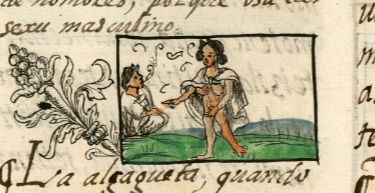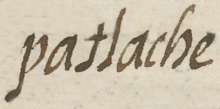patlache (FCbk10f40v)
This iconographic example, featuring an intersex person (patlache,or patlacheh, with the added glottal stop), is included in this digital collection for the purpose of making possible comparisons with related hieroglyphs. The term selected for this example comes from the text near the image in the Digital Florentine Codex. There is no gloss, per se. This example shows two people, a person dressed in women’s clothing seated on the viewer’s left, and an intersex person (patlache) standing on the viewer’s right. Their clothing has been shaded to give it a three-dimensionality, showing European artistic influences. The focus is the person on the right, who wears only a man’s cloak (tilmatli) and is otherwise nude. This person does have an adult woman’s hairstyle (neaxtlahualli) and large breasts, but the abdominal musculature reminiscent of what is today called a “six-pack.” The person’s left arm is hanging down, and the hand covers the spot where the genitals might otherwise be seen, leaving them ambiguous. But the text refers to a woman with a penis (“cioatl xipne tepule”). With the right hand, the patlache points (mapilhuia) to the person seated. Such a gesture can often suggest some degree of authority. The two people also enter into a conversation, with speech scrolls going both directions. Having a voice could also suggest some authority. One of the scrolls coming from the person who is seated seems to have a flower attached to it, which could suggest that the conversation is pleasant and/or perhaps about sexuality and fertility. If we can trust the translation by Anderson and Dibble, the text refers to the patlache as “she” and “her,” female even if manlike, and someone who has sexual relations with other women, which leads to the DFC keywording team to add “lesbian.”
Stephanie Wood
Cross-cultural translation challenges may obscure what is a transgendered person, perhaps someone who has rejected an assignment of gender at birth and made a transition. Similarly, this person may have had physically ambiguous anatomy, got assigned a certain (mistaken) gender, and then the individual later sought to reassess that. What’s more, it would also be an erasure to fail to recognize the possibility that the imagery and the text are making an effort to describe a lesbian, one of several possibilities. As of September 2025, there are no glyphs of a patlache in this digital collection. The most notable gender question arises in this collection when men have names involving “cihuatl.” See a few examples below.
Stephanie Wood
patlache
Stephanie Wood
1577
Jeff Haskett-Wood
hermafrodita, lesbiana, pronouns, pronombres, sexualidad, intersexualidad, género
patlache, an intersex person, https://nahuatl.wired-humanities.org/content/patlache
una persona intersexual
Stephanie Wood
Available at Digital Florentine Codex/Códice Florentino Digital, edited by Kim N. Richter and Alicia Maria Houtrouw, "Book 10: The People", fol. 40v, Getty Research Institute, 2023. https://florentinecodex.getty.edu/en/book/10/folio/40v/images/0 Accessed 10 September 2025.
Images of the digitized Florentine Codex are made available under the following Creative Commons license: CC BY-NC-ND (Attribution-NonCommercial-NoDerivs 4.0 International). For print-publication quality photos, please contact the Biblioteca Medicea Laurenziana ([email protected]). The Library of Congress has also published this manuscript, using the images of the World Digital Library copy. “The Library of Congress is unaware of any copyright or other restrictions in the World Digital Library Collection. Absent any such restrictions, these materials are free to use and reuse.”





